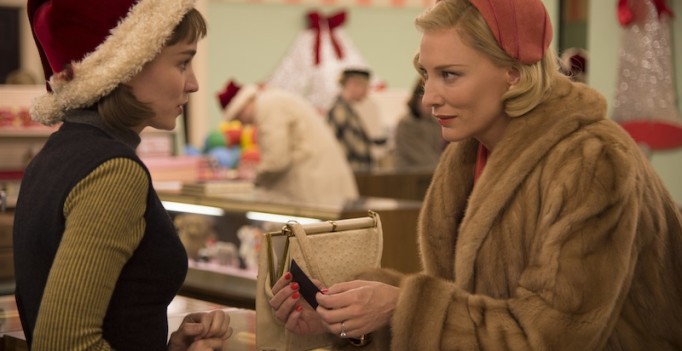By: Mark Barber
Carol is a difficult film to describe without context. I have occasionally found myself at odds with contemporary representations of queer identity, as it refuses to abandon elements of tragedy that have dominated for so long. As Vito Russo points out in his celebrated The Celluloid Closet, queer characters rarely receive a happy ending. Same-sex relationships were taboo for much of the 20th century, which was then reflected in their filmic representation. The presence of tragedy in 80s and 90s queer cinema made social and political sense because of the devastating AIDS crisis. Given the progress of the LGBT rights movement, it’s unusual to see queer characters so routinely killed off and denied happiness in contemporary cinema.
This isn’t to say that dramatic tension and tragedy in queer culture should be discontinued. But, progressive depictions of queer identity are too often laboured by the encroaching and alienating neoliberal rhetoric dominating the equality movement (which often suppresses voices of queer people of colour and transpeople). Departing from these trends, Todd Haynes offers something different with Carol. Exploring the romance between wealthy almost-divorcee Carol Aird (Cate Blanchett) and burgeoning photographer Therese Belivet (Rooney Mara). The film takes place in the 1950’s, where same-sex relationships were to driven to the most private margins of society.
Haynes work has periodically taken thematic, formal, and narrative cues from the melodramas of Douglas Sirk, whose films have frequently been re-analyzed through a queer lens. Carol is arguably a revisionist melodrama. While maintaining the authenticity of the depicted period (queer invisibility is evident through the characters’ reluctance to utter the word “homosexual,” regardless of whether or not it is of bigoted intention), Haynes depicts a queer relationship in a melodramatic setting that evident rather than absent, and progressive rather than punitive.
Haynes’ film deserves to be seen and praised based on this area alone, but I would be remiss if I did not praise it for its other qualities. The film, shot in 16mm, is gorgeous, yet its style is understated (a rarity, given the medium’s dependence on overwhelming, excessively beautiful films like Sorrentino’s Youth). Blanchett and Rooney also deliver fine performances and share a potent chemical bond.
Intellectually and emotionally stimulating, Carol is one of the best films of the year.
**********
Do You Tweet? Follow These Tweeple:
Mark Barber: @WorstCinephile





Be the first to comment